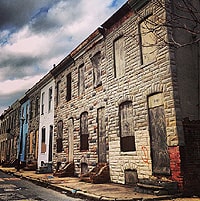RPG Architecture Question
Mon, Aug 31, 8:03 PM (18 hours ago)
Hi James,
I'm generating random charts for my game. Today's question is "what kinds of architecture / buildings" does a slowly collapsing empire tend to build?
I'm imagining a scenario where an empire finds itself suddenly quite overstretched, unable to adequately defend all of its territory at once. Is this, historically, when empires build their great walls? I'm imagining situations where a sovereign has to desperately shuffle troops between locations: walls, towers, depots, etc. What do you see?
It's not an era of new cities or new canals, right? People left behind by the empire are building primitive fortifications, and warlords fill in the vacuum. But the old empire still thinks this is temporary, or just can't bring itself to see the scope of the problem. It's all about the small, low footprint fast response force.
Thoughts?
Polynimbus
Polynimbus, the fate of most civilizations has been to have their remnants become the basements of another age or to be overrun by the forces of nature, despite the postmodern conceit that Humanity controls nature like a whipped dog and that our burning stuff contributes more to climate change than the cycles of the sun.
I will use various examples from history and fiction of what happens to peak prosperity architecture.
-1. Feral Occupancy, the classic Howard, Burroughs lost city setting, in Tarzan and the Jewels of Opar and Xuthal of the Dusk and Red Nails Conan yarns
-2. Cannibalism, the use of the Colloseum walls to build medieval housing
-3. Abandoned to Nature, Mayan and Hittite ruins and Machu Picchu
-4. Cultic Center, use of the catacombs and cellars of abandoned civic centers for secret worship
-5. Criminal Refuge, the fate of abandoned forts
-6. Desecration, the use of catholic cemetery's to build masques in Skulker Jones and Aztec temples to build churches in Mexico
-7. Monument, perhaps the fate of a skyscraper or two, just as the sphinx and the pyramids and the Toltec ruins served as places of wonder concerning earlier peoples to the civilizations of Egypt and Mexico
To your specific point, if we use the Roman example, we can see that the walls and "limes" along the Rhine and in the north of Britain, were constructed after a second flowering, a successful reboot and resurgence by an empire that knows it is buying time and has had reverses before [A.D.100s]. When these artifices fail, and they will, then you see the rise of mobile strike-force style armies instead of garrisons and the use of outsiders as mercenaries [A.D. 300s].
Typically, monumental architecture in the form of statuary and celebrations of conquest, like the Partheneon in Athens, which preceded the building of the long walls to the sea by a decade, and the Column of Trajan, which preceded the building of Hadrian's wall by a single reign, mark the high water mark of empire—then follows crises, wall-building and decay.
The U.S., due to geographic isolation and lack of will has never had a wall-building phase, not even by the president elected to do just that. On could argue that the building of the greatest Navy and air force in Human history in about 1940, was in effect the construction of America's walls, engaged in a generation after the general abandonment of civic, monumental architecture.
Walls are a sign of decay of offensive capacity.
Trajan might have struck out and conquered, but he did so largely with barbarian mercenaries and his legions were really only good for static duty, to be garrisons. So Hadrian bowed to masculine Roman decay and built walls.
Further sign of decay is the permission to settle within the empire by outsiders, and especially defeated enemies.
Throughout this long cycle, buildings will be less permanent, will tend to use materials from greater buildings and also repurpose them.
Some examples:
When the Aztec empire was taken by a handful of Spaniards, you ended up with an architectural situation similar to modern America and Christianized Rome, where the people remained largely the same, but their operating system—being their religion—changed, and this change was reflected in desecration of monuments, repurposing of holy sites [like modern churches now being predominantly drug treatment and refugee resettlement locations] for holy or civic purposes.
As the empire breaks into feudal components civic sites, such as stadiums might become refugee camps, the villas of the rich might be repurposed as monasteries and other holy sites.
The great constants are:
-Abandonment of monumental architecture, such as the U.S. in 1913
-Turning to professional and mercenary military such as the U.S. from 1976-2004
-The subdivision and rental of elite housing, 1985, U.S.
-Renting and squatting in family housing, with subsidized housing essentially a government sponsored squatting program, 1965, U.S.
-Wall building as a demarcation between resurgence and retraction of power, like the U.S. trying and failing to raise a fence in 4 years
-Reduction, desecration and repurposing of sacred architecture, Current U.S.
-Removal and defacing of monumental architecture, current U.S.
-Dismantling of civic buildings for private use, such as stripping copper in U.S. cities by homeless
-Building of less durable structures on top of the foundations of classic buildings, such as placing huts and cabins and clapboard houses on the basement of ancient stone buildings, and the current practice of selling the brick and timber of early 1900s Baltimore row homes to the hipster elite and replacing these houses with cheap prefabricated dwellings.
-Abandonment of cities and the building of less durable dwellings and civic and sacred places in outlying areas, such as happened in Europe during the Dark Ages and in the U.S. beginning in 1946.
I hope this helps, Polynimbus.
Note
American, Roman and Inca road building were post imperial and intended as internal lines of logistic and economic defense, as were the massive water management projects in Rome and the U.S. By monumental architecture I mean economically useless expression of emotive, sacred and sentimental construction, such as statues, Trajan's column, the Partheneon and the Taj Mahal. Such buildings are generally indications of imminent decline in the next generation as a nation rests on its laurels and grows soft, empty and dedicated to sloth.











JL: "...economically useless expression of emotive, sacred and sentimental construction, such as statues, Trajan's column, the Partheneon and the Taj Mahal. Such buildings are generally indications of imminent decline in the next generation as a nation rests on its laurels and grows soft, empty and dedicated to sloth."
Add Arc de Triomphe to that list.
Which would be the best example. Thanks!
I disagree somewhat. Check out Sacré-Cœur, The Basilica of the Sacred Heart of Paris. For both the Arc and the Basilica, for me at least, it’s interesting to note when they were commissioned and when they were finally completed and dedicated, and how things changed even in that time period. Also of note in my opinion, is that the former was explicitly about Triumph whereas the latter was explicitly about expiation and then —well, you can read the Wikipedia but it strikes me as in line with an attempted re-boot of the civilization by means of, or with, the assistance of the sacred. Finally, is it just me or does the Basilica look a bit like the Taj Majal?
So if it’s one combined thing, then ok, sure, I’ll demure to the Arc. But if there’s an important distinction between the Triumph, celebration of conquest, ‘we’re number one and on the verge of long term superiority’ type of monument, and the Sacred, ‘emotive, sacred and sentimental’ re-boot type, then Paris has both.
Good point, sir.
American Krushschyovka:
granolashotgun.com/2020/01/14/%D0%B0%D0%BC%D0%B5%D1%80%D0%B8%D0%BA%D0%B0%D0%BD%D1%81%D0%BA%D0%B0%D1%8F-%D1%85%D1%80%D1%83%D1%89%D0%B5%D0%B2%D0%BA%D0%B0
This sort of thing is built throughout the West.
Thanks